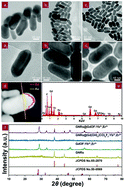当前位置:
X-MOL 学术
›
Dalton Trans.
›
论文详情
Our official English website, www.x-mol.net, welcomes your feedback! (Note: you will need to create a separate account there.)
Multimodal imaging and photothermal therapy were simultaneously achieved in the core–shell UCNR structure by using single near-infrared light
Dalton Transactions ( IF 4 ) Pub Date : 2017-08-15 00:00:00 , DOI: 10.1039/c7dt02791e Chen Wang 1, 2, 3, 4, 5 , Liangge Xu 1, 2, 3, 4, 5 , Jiating Xu 1, 2, 3, 4, 5 , Dan Yang 1, 2, 3, 4, 5 , Bin Liu 1, 2, 3, 4, 5 , Shili Gai 1, 2, 3, 4, 5 , Fei He 1, 2, 3, 4, 5 , Piaoping Yang 1, 2, 3, 4, 5
Dalton Transactions ( IF 4 ) Pub Date : 2017-08-15 00:00:00 , DOI: 10.1039/c7dt02791e Chen Wang 1, 2, 3, 4, 5 , Liangge Xu 1, 2, 3, 4, 5 , Jiating Xu 1, 2, 3, 4, 5 , Dan Yang 1, 2, 3, 4, 5 , Bin Liu 1, 2, 3, 4, 5 , Shili Gai 1, 2, 3, 4, 5 , Fei He 1, 2, 3, 4, 5 , Piaoping Yang 1, 2, 3, 4, 5
Affiliation

|
Core–shell nanostructures consisting of plasmonic materials and lanthanide-doped upconversion nanoparticles (UCNPs) show promising applications in theranostics including bio-imaging, diagnosis and therapy. However, some challenges still remain in the synthetic control because of the non-coordination between energy transfer and photothermal therapy (PTT). Herein, we developed a novel type of thermal-fluorescent core–shell hybrid nanocomposite incorporating rare-earth Yb3+ and Er3+ ion doped GdOF as the shell and gold nanorods (GNRs) as the core, creating upconversion nanorods (UCNRs) of GNRs@GdOF:Yb3+,Er3+. In order to facilitate the absorption or excretion of UCNRs in vivo, we designed gold nanorods with lower aspect ratios by reducing the amount of CTAB in the growth solution. More importantly, under 980 nm near-infrared (NIR) light irradiation, the green and red emissions of GdOF:Yb3+,Er3+ generally overlap with the visible absorbance of GNRs; by altering the contents of Yb3+ and Er3+ ions appropriately, the localized surface plasmon resonance (LSPR) absorption of low aspect ratio GNRs under 980 nm NIR laser excitation can be enhanced for improving the PTT efficiency. Furthermore, in vitro and in vivo assays reveal that the composite has excellent bio-compatibility and cancer therapy efficiency. This multi-functional nanocomposite, which possesses upconversion luminescence and photothermal and biocompatibility properties, shows strong potential for application in bio-imaging and photothermal anti-cancer therapy.
中文翻译:

通过使用单个近红外光,在核-壳UCNR结构中同时实现了多模态成像和光热疗法
由等离激元材料和镧系元素掺杂的上转换纳米粒子(UCNPs)组成的核-壳纳米结构在包括生物成像,诊断和治疗在内的肿瘤治疗学中显示出广阔的应用前景。但是,由于能量转移和光热疗法(PTT)之间的不协调,合成控制中仍然存在一些挑战。在这里,我们开发了一种新型的热荧光核-壳杂化纳米复合材料,其中掺入了稀土Yb 3+和Er 3+离子的GdOF作为壳,并以金纳米棒(GNR)为核心,产生了纳米级的上转换纳米棒(UCNR)。 GNRs @ GdOF:Yb 3+,Er 3+。为了促进体内UCNR的吸收或排泄,我们通过减少生长溶液中CTAB的量来设计具有较低长宽比的金纳米棒。更重要的是,在980 nm的近红外光照射下,GdOF:Yb 3+,Er 3+的绿色和红色发射通常与GNRs的可见吸收重叠。通过适当改变Yb 3+和Er 3+离子的含量,可以提高低纵横比GNR在980 nm NIR激光激发下的局部表面等离子体共振(LSPR)吸收,从而提高PTT效率。此外,在体外和体内分析表明该复合材料具有出色的生物相容性和癌症治疗效率。该多功能纳米复合材料具有上转换发光,光热和生物相容性特性,在生物成像和光热抗癌治疗中显示出强大的潜力。
更新日期:2017-09-20
中文翻译:

通过使用单个近红外光,在核-壳UCNR结构中同时实现了多模态成像和光热疗法
由等离激元材料和镧系元素掺杂的上转换纳米粒子(UCNPs)组成的核-壳纳米结构在包括生物成像,诊断和治疗在内的肿瘤治疗学中显示出广阔的应用前景。但是,由于能量转移和光热疗法(PTT)之间的不协调,合成控制中仍然存在一些挑战。在这里,我们开发了一种新型的热荧光核-壳杂化纳米复合材料,其中掺入了稀土Yb 3+和Er 3+离子的GdOF作为壳,并以金纳米棒(GNR)为核心,产生了纳米级的上转换纳米棒(UCNR)。 GNRs @ GdOF:Yb 3+,Er 3+。为了促进体内UCNR的吸收或排泄,我们通过减少生长溶液中CTAB的量来设计具有较低长宽比的金纳米棒。更重要的是,在980 nm的近红外光照射下,GdOF:Yb 3+,Er 3+的绿色和红色发射通常与GNRs的可见吸收重叠。通过适当改变Yb 3+和Er 3+离子的含量,可以提高低纵横比GNR在980 nm NIR激光激发下的局部表面等离子体共振(LSPR)吸收,从而提高PTT效率。此外,在体外和体内分析表明该复合材料具有出色的生物相容性和癌症治疗效率。该多功能纳米复合材料具有上转换发光,光热和生物相容性特性,在生物成像和光热抗癌治疗中显示出强大的潜力。


























 京公网安备 11010802027423号
京公网安备 11010802027423号